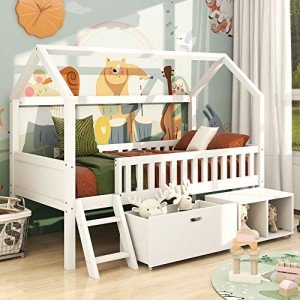Exploring Bunk Beds: A Comprehensive Guide
Bunk beds have long been a staple in kids's bedrooms, dorm rooms, and even homes with minimal space. Not only do they supply a practical sleeping solution, but they likewise create a fun and creative environment for children and a great space-saver for adults and families. This short article will check out whatever you require to understand about bunk beds, from types and materials to security suggestions and purchasing advice.
Tabulation
- Kinds Of Bunk Beds
- Standard Bunk Beds
- Loft Beds
- Triple Bunk Beds
- L-Shaped Bunk Beds
- Material Options
- Wood
- Metal
- Security Considerations
- Purchasing Guide
- FAQs
Types of Bunk Beds
Bunk beds can be found in numerous designs to fit various needs and preferences. Here's a breakdown of the most typical types:
Conventional Bunk Beds
Conventional bunks usually feature 2 beds stacked vertically on top of one another. These beds are perfect for brother or sisters sharing a space or for making the most of sleeping space in guest spaces.
Loft Beds
Loft beds stand similarly to traditional bunk beds however do not have a lower sleeping location. Instead, they frequently incorporate a desk or seating area beneath, making them a great option for small rooms requiring multifunctionality.
Triple Bunk Beds
Triple bunk beds are developed for 3 residents, with beds stacked in a three-tier configuration. These are less typical but can be an enjoyable service for large families or sleepovers.
L-Shaped Bunk Beds
With one bed placed horizontally and the other vertically, L-shaped bunk beds are often geared up with additional features such as desks or storage drawers and can complement corner spaces in a space.
Contrast of Bunk Bed Types
| Bed Type | Suitable Use | Description |
|---|---|---|
| Standard | Shared bed rooms or guest spaces | Two beds stacked vertically |
| Loft | Little rooms requiring multi-purpose space | Upper bed with open space underneath |
| Triple | Large families or pajama parties | Three beds stacked vertically |
| L-Shaped | Corner or flexible areas | A combination of vertical and horizontal beds |
Product Options
Bunk beds are made from various products, with wood and metal being the most common. Each product has its benefits and drawbacks.
Wood
- Resilience: Generally robust and can withstand years of use.
- Aesthetic Appeal: Offers a traditional appearance that can mix with various decorations.
- Weight Capacity: Typically stronger; can support much heavier weights.
- Downsides: May be more expensive than metal options and can be prone to scratches.
Metal
- Sturdiness: Generally lightweight and simple to move but still sturdy.
- Modern Design: Often is available in streamlined designs, making it appealing for contemporary areas.
- Economical: Usually less costly than wooden alternatives.
- Downsides: Can be cold to the touch in winter seasons and may not have the same aesthetic appeal for some buyers.
Security Considerations
When it comes to bunk beds, security can not be ignored. Here are crucial safety ideas to remember:
- Guardrails: Ensure that the leading bunk has guardrails on both sides to avoid falls.
- Durable Construction: Check for a solid construct and strong products to hold up against weight and movement.
- Weight Limit: Adhere to the manufacturer's weight limit for both the upper and lower bunks.
- Ladder Design: Choose bunks with a safe, easy-to-climb ladder and prevent any sharp edges or rungs.
- Age Restrictions: Most makers advise that kids under the age of six need to not sleep in the upper bunk.
Buying Guide
When searching for bunk beds, think about the following elements to find the best suitable for your requirements:
- Space Availability: Measure the space size and ceiling height, making sure there is appropriate space for the leading bunk.
- Bed Size: Decide between twin, full, or bigger sizes based upon your needs and the size of the room.
- Style Preference: Consider the general design of the bedroom to find an ideal style.
- Ease of Setup: Look for a bunk bed that is uncomplicated to assemble.
- Budget: Bunk beds can be found in various price varieties, so figure out a spending plan before starting your search.
FAQs
1. What is the recommended age for kids to sleep on the top bunk?
Children aged six and older are usually advised to sleep on the leading bunk to minimize the threat of falls.
2. How can I make my bunk bed more secure?
To boost safety, ensure guardrails are correctly installed and check that the bed is put on a flat surface area. Additionally, motivate children to use the ladder thoroughly.
3. Can I transform a bunk bed into two separate beds?
Numerous bunk beds are developed to be convertible. Examine the producer's specs for convertibility functions.
4. What accessories are offered for bunk beds?
Common devices consist of bed linens, storage drawers, staircases rather of ladders, and tented canopies for an enjoyable visual appeal.
5. How do I maintain my bunk bed?
Regular checks for loose screws or structural integrity can help ensure security. Dust the bed routinely and tidy spills immediately to keep the materials in good condition.
Bunk beds are versatile and a space-efficient solution for different living scenarios, from kids's rooms to guest accommodations. With Bunk Beds For Adults UK and materials offered, possible buyers have a wealth of alternatives to consider, making sure a mix of functionality and aesthetic appeals. By Bunk Beds For Adults UK and following the suggestions laid out in this guide, people can find the ideal bunk bed that suits their space and lifestyle, all while producing an enjoyable sleeping environment.

